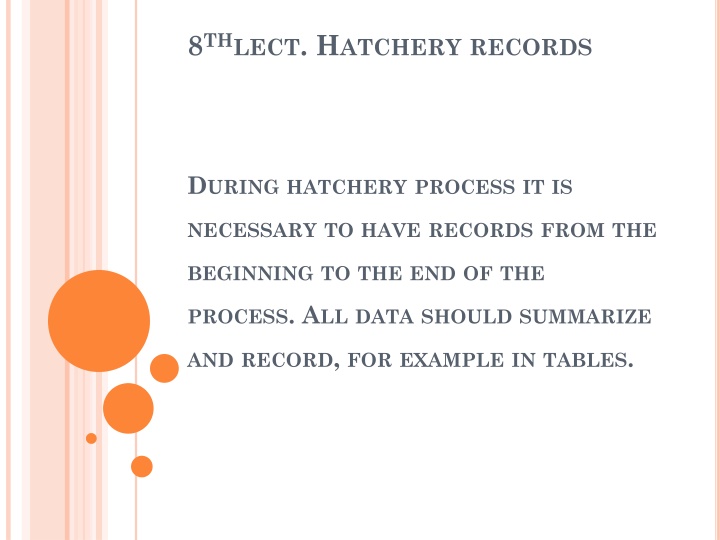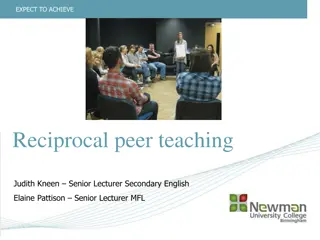
Optimizing Hatchery Processes: Records, Measurements, and Waste Management
Ensure successful hatchery processes by maintaining detailed records from start to finish, conducting measurements on day-old chicks, and managing hatchery waste effectively. Learn how to calculate fertility and hatchability percentages, handle hatchery waste, and separate waste components for proper treatment.
Download Presentation

Please find below an Image/Link to download the presentation.
The content on the website is provided AS IS for your information and personal use only. It may not be sold, licensed, or shared on other websites without obtaining consent from the author. If you encounter any issues during the download, it is possible that the publisher has removed the file from their server.
You are allowed to download the files provided on this website for personal or commercial use, subject to the condition that they are used lawfully. All files are the property of their respective owners.
The content on the website is provided AS IS for your information and personal use only. It may not be sold, licensed, or shared on other websites without obtaining consent from the author.
E N D
Presentation Transcript
8THLECT. HATCHERY RECORDS DURING HATCHERY PROCESS IT IS NECESSARY TO HAVE RECORDS FROM THE BEGINNING TO THE END OF THE PROCESS. ALL DATA SHOULD SUMMARIZE AND RECORD, FOR EXAMPLE IN TABLES.
Tableof Hatchery Hatchability % Fertility rate (%) Fertile Eggs Abnormal Chicks Notes Receive date Incubation date No. of incubated eggs Transfer date Hatchin g date No. chicks Dead Embryo
Measurements after hatching directly: These qualities measured in 1 day old, the chicks weighed by a delicate digital balance and then take the average of the five treatments. And also broken all the non-hatched eggs and then calculate the number of fertilized eggs. After hatching completed dead embryos and unfertilized eggs removed, good chicks directly transferred to the field for the purpose of rearing. The manager should calculate the number of good, abnormal and dead chicks to obtain the percentages of fertility and hatchability.
The fertility percentage also calculated in the following equation: Number of fertilized eggs * Fertility (%) = ------------------------------------ 100 Total number of eggs
Also the percentage of hatched chicks calculated at the end of the day 21 of hatching, the percentage of hatching calculated from fertilized eggs and total eggs as in the following equations: Number of hatched chicks 1- Hatchability% (fertilized eggs) = -------------------------------------- 100 Number of fertilized eggs Number of hatched chicks 2- Hatchability% (total eggs) = -------------------------------------- 100 Number of total eggs
Handling of Hatchery Waste The poultry industry produces large amounts of hatchery waste which includes solid waste and wastewater. The solid hatchery waste comprises empty shells, infertile eggs, dead embryos, late hatchings, dead chickens and decaying tissue. The wastewater comes from water used to wash down incubators, hatchers and chick handling areas.
Separation of Waste at the Hatchery Hatchery waste can be separated into solid and liquid components and then treated separately. For example, the liquid in hatchery waste can be separated from the solid hatchery waste by spinning. In other industries a flexible multi-layer filter can be used to separate liquid wastes from solid wastes.
Methods to recycle egg shells 1) The pure shell powder can be used in the paper industry, or as a limestone substitute or calcium supplement in agriculture. 2) mixed with garden soil for use as a fertilizer. 3) fine pieces of crushed egg shell mixed with seeds for use as a feed for aviary birds. 4) used by artists to make mosaics by coloring . 5) used to make textured paint for 3D effects in artwork. 6) eggs shells can be composted to increase the mineral content of the compost.
Hatchery Waste treatments; 1- Power generation; The hatchery waste can be automatically fed by conveyor belts into a furnace which is equipped by rotating unit for chopping and grinding solid waste. It can power a turbine generator to produce electricity for hatchery.
2- Autoclaving and extrusion; Extruded or autoclaved hatchery waste (infertile eggs or eggs with dead embryos) and dried it at 100 C for 10 h. Or autoclaved day-old cull male chicks for 30 min. The autoclaved hatchery waste The product was dried and powdered used as livestock feed. 3- Boiling; Dead embryos could be boiled for 100 C for 30 min, soaked in cold water for 20 min to remove shells, sun dried for 4d and used in poultry feed. It contain 36% CP, 27% ether extract, 17% ash, 10% calcium and 0.6% phosphorus.
4- Composting; Composting is a common method for solid organic waste disposal. The decomposition of organic waste is performed by aerobic bacteria, yeasts and fungi. The composting process with litters kills pathogens eliminated 99.99% of E. coli and Salmonella. Converts ammonia nitrogen to organic nitrogen. The product can be used as a fertilizer. When hatchery waste is composted with poultry litter it will produce a safe and rich organic product which is a good organic fertilizer. The product contains nitrogen, phosphorus and potassium. The product also contains high calcium and other micro- nutrients. Disadvantages of composting are loss of some nutrients including nitrogen for the composting and odour problems.




















